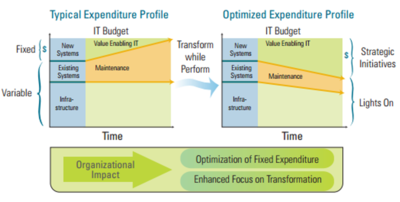IT Cost Optimization
The concept of optimizing IT sounds logical, but opinions vary on what the term “IT optimization” really means. What does it really mean and what are the benefits to IT departments and the organizations they serve? Optimization is a two-fold IT asset management solution that aims to reduce costs associated with delivering IT solutions, alongside leveraging current IT assets to provide organizational value. The blending of these two philosophies generates IT optimization that truly reduces costs, mitigates business risk, and lays the foundation for new business opportunities.[1]
A structured approach to cost optimization can:[2]
- Embed a culture of cost management throughout the business
- Improve cash flows position, balance sheet and performance
- Improve accounts payable, accounts receivable and aged debtor collections
- Generate efficiencies around production, inventory and supply processes
- Create flexible and agile operating and business processes
- Streamline traditional financial and regulatory processes to reduce costs and free up resources
- Simplify planning, sourcing, collaboration and supy chain execution
Typically, successful cost optimization efforts produce positive ROI that sets the business up for future growth.
Gartner's IT Cost Optimization Framework

source: Gartner
Key Principles of IT Cost Optimization[3]
According to Gartner's report Five Principles Underpin IT Cost Optimization Success the difference between organizations that optimize cost cutting and those that don't isn't the level of effort or the number of initiatives taking place. Success typically revolves around five guiding principles that create a long-term focus rather than specific short-term financial targets.
The five principles encompass:
Transparency. - greater transparency translates to better supply and demand decisions. This, in turn, helps organizations optimize costs the right way. By defining business outcomes, an enterprise can better weigh the effectiveness of transparency. However, this approach isn't possible until IT and the business have explicitly agreed on what IT provides the business and what the business needs from IT. A quantitative assessment that defines consumption, drivers and inhibitors for IT and business services is essential. This leads to better prioritization and consensus about optimization opportunities.
Agility. Organizations that achieve continuous optimization typically display a high level of agility and adaptability. They also recognize that the goal isn't to merely lower IT costs but to adopt a more efficient and cost-effective long-term sourcing strategy. In most cases, this means moving away from a focus on contracts that create fixed pricing and moving to a variable model.
Accountability. Organizations must review both supply and demand side issues that involve IT resources. According to Solanki, IT often becomes reactive to business requirements because organizations view optimization within the prism of how to best supply the demand for technology. However, this approach creates a "reactive" culture. Instead, leaders must take ownership and use devices such as chargebacks and showbacks to create greater accountability.
Simplification. Reducing complexity generally leads to cost optimization, Gartner notes. Although IT systems are inherently complex, enterprises can benefit by introducing standard platforms, consistent business processes, and clearly defined IT services and service levels. Gartner's IT key metrics data indicates that best-in-class performers in this area spend 38 percent less than average performers to deliver similar results.
Discipline. Gartner stresses that IT cost optimization isn't a one-and-done initiative and CIOs can't view it as a series of discreet projects. What's more, successful cost optimization revolves around CIO ownership and the use of dashboards and metrics to focus on longer-term cost efficiencies. Finally, best practice organizations frequently rely on a cross-functional team to oversee an initiative.
IT Cost Optimization Framework and Methodology[4]
Cognizant Business Consulting has developed a framework and related methodology to help IT leaders meet cost-cutting objectives while preserving ongoing business transformation initiatives. The framework is based on experience in working with companies that are facing the challenge of delivering new business capabilities despite facing resource constraints for funding them. Through a repeatable, six-step methodology (see Figure below), the framework enables companies under duress to do the following:
- Assess their IT budgets and pinpoint optimization opportunities.
- Collaborate with a strategic partner on new ideas to drive effective cost management.
- Identify short- and long-term savings from IT resources and optimizations.
- Syndicate an implementation roadmap to transform cost-savings opportunities into reality.

source: Cognizant
It is not unusual, but neither is it optimal, in organizations,for maintenance, application development and infrastructure costs to squeeze out the ability to be strategic (see Figure below). A structured and detailed cost-optimization framework and underlying methodology and governing principles can specify the savings potential in all of these areas so the client can focus on strategy.[5]

source: Cognizant
See Also
IT Financial Management (ITFM)
Technology Business Management (TBM)
IT Chargeback
IT Cost Allocation
Federal IT Acquisition Reform Act (FITARA)
Total Cost of Ownership (TCO)
References
- ↑ IT Optimization: What Is It and Why Does It Matter to Organizations? datatrend.com
- ↑ A structured approach to cost optimization kpmg.de?
- ↑ Principles of IT Cost Optimization CIO Insight
- ↑ IT Cost Optimization Framework and Methodology staging.net/InsightsWhitepapers/IT_Cost_Optimization.pdf Cognizant
- ↑ IT Cost Optimization - Getting There from Here Inight Whitepapers
Further Reading
- IT Cost Optimisation, A Game of Many Halves Kevin Duffy, Gartner Consulting
